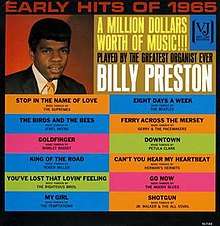Early Hits of 1965
Early Hits of 1965, subtitled A Million Dollars Worth of Music!!! Played by the Greatest Organist Ever, is an album by Billy Preston performing soul arrangements of hit singles from that year recorded in the same sessions of The Most Exciting Organ Ever and originally released by the Vee-Jay label and re-released by Exodus Records the following year.[1][2][3]
| Review scores | |
|---|---|
| Source | Rating |
| Allmusic | |
| Early Hits of 1965 | ||||
|---|---|---|---|---|
 | ||||
| Studio album by | ||||
| Released | 15 December 1965 | |||
| Recorded | March-September, 1965 | |||
| Genre | Soul | |||
| Length | 24:20 | |||
| Label | Vee-Jay VJLP/VJS 1145 | |||
| Producer | Steve Douglas | |||
| Compiler | Billy Preston | |||
| Billy Preston chronology | ||||
| ||||
Track listing
- "Stop! In the Name of Love" (Holland–Dozier–Holland) – 2:26
- "The Birds and the Bees" (Barry Stuart) – 1:59
- "Goldfinger" (John Barry, Leslie Bricusse, Anthony Newley) – 2:20
- "King of the Road" (Roger Miller) – 2:12
- "You've Lost That Lovin' Feelin'" (Phil Spector, Barry Mann, Cynthia Weil) – 2:20
- "My Girl" (Smokey Robinson, Ronald White)
- "Eight Days a Week" (John Lennon, Paul McCartney) – 2:10
- "Ferry Cross the Mersey" (Gerry Marsden) – 2:52
- "Downtown" (Tony Hatch) – 2:40
- "Can't You Hear My Heartbeat?" (John Carter, Ken Lewis) – 2:02
- "Go Now" (Larry Banks, Milton Bernett) – 2:45
- "Shotgun" (Autry DeWalt) – 2:30
gollark: garbage: you have, however, doomed yourself to an eternity of very closely watching any bees near you.
gollark: Surprisingly, <@80528701850124288> never has.
gollark: Which is less cool.
gollark: Oh, right, it would have to be *contra*gollarious crusade.
gollark: Gollarious Crusade could be REALLY cool™.
References
- Billy Preston discography, accessed July 25, 2019
- Both Sides Now: Vee-Jay Album Discography, Part 2: Main Series VJS-1071 to VJS-1154 (1963-1965), accessed July 25, 2019
- Both Sides Now: Exodus Album Discography, accessed July 25, 2019
- "Early Hits - Billy Preston". Allmusic. Retrieved 18 March 2012.
This article is issued from Wikipedia. The text is licensed under Creative Commons - Attribution - Sharealike. Additional terms may apply for the media files.